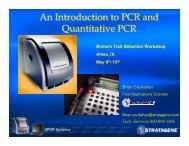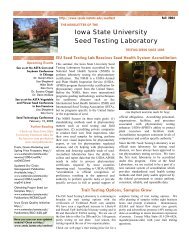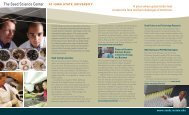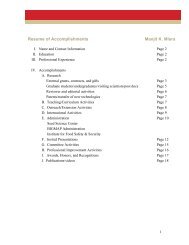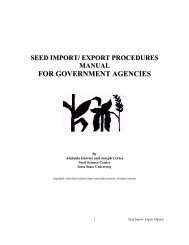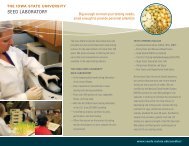Confined Production Processes for Non-Food Corn - Seed Science ...
Confined Production Processes for Non-Food Corn - Seed Science ...
Confined Production Processes for Non-Food Corn - Seed Science ...
You also want an ePaper? Increase the reach of your titles
YUMPU automatically turns print PDFs into web optimized ePapers that Google loves.
No system is risk free, but some systems have very lowrisks in comparison with systems that society commonlyuses without special concern, <strong>for</strong> example, automobilesand gasoline trucks. Risks <strong>for</strong> others may be higher. Thesize of the risk may vary with policies that are adopted.The objective the BIGMAP study is to make future policymaking easier and more meaningful by developing prototypemodels that can be used in determining where on thescale specific types of plant-manufactured pharmaceuticalor -industrial compound production systems shouldbe ranked.VII. REFERENCESAdair, D., Irwin R., and Traynor, P.L. 2001. A practical guide to containment.Blacksburg, VI: In<strong>for</strong>mation Systems <strong>for</strong> Biotechnology.Bateman, A.J. 1947. Contamination of seed crops II, wind pollination.Heredity 1:235–246.Burris, J.S. 2001. Adventitious pollen intrusion into hybrid maize seed productionfields. Association of Official <strong>Seed</strong> Certifying Agencies [AOSCA]. Accessedelectronically June 9, 2004,http://www.amseed.com/govt_statementsDetail.asp?id=69.Coe, E.H., Jr., Neuffer, M.G., and Hoisington, D.A. 1998. The genetics of corn, pp.81–258. In: <strong>Corn</strong> and corn improvement, agronomy monograph no. 18, ed. G.F.Sprague and J.W. Dudley, Madison, WI: American Society of Agronomy.Das, K.G.S. 1983. Vicinity distance studies of hybrid seed production in maize(Zea mays L.) at Bangalore. Mysore J. Agric. Sci. 20:320.Eastham, K. and Sweet, J. 2002. Genetically modified organisms (GMOs):The significance of gene flow through pollen transfer. Environ. Issue Rep.No. 28. Copenhagen, Denmark: European Environmental Agency.Emberlin, J., Adams-Groom, B., and Tidmarsh, J. 1999. A report on the dispersalof maize pollen. Worcester, United Kingdom: National Pollen Research Unit,University College.Fonseca, A.E., Westgate, M.E., and Doyle, R.T. 2002. Application of fluorescencemicroscopy and image analysis <strong>for</strong> quantifying dynamics of maize pollenshed. Crop Sci. 42:2201–2206.Garcia, C., Figueroa, M.J., Gomez, M.R., Townsend, L.R., and Schoper, J. 1998.Pollen control during transgenic hybrid maize development in Mexico.Crop Sci. 38:1597–1602.Hall, A.J., Villela, F., Trapani, N., and Chimenti, C. 1982. The effect of waterstress and genotype on the dynamics of pollen-shedding and silking in maize.Field Crops Res. 5:349–363.Hutchcroft, C.D. 1958. Contamination in seed fields of corn resulting fromincomplete detasseling. Agron J. 66:267–271.Ingram, J. 2000. Report on the separation distances required to ensure crosspollinationis below specified limits in non-seed crops of sugar beet, maize,and oilseed rape. MAFF Project no. RO0123. Accessed electronicallyAugust 7, 2002, http://www.defra.gov.uk/planth/pvs/gmsepdis.pdf.Ireland, D. S., Westgate, M.E., and Ashton, B.A. 2001. Combining ISCST3 andAERMOD particulate dispersion models to quantify maize pollen distribution.ASA-CSSA-SSSA Annual Meetings Abstracts, Charlotte, NC. October 21–25,2001. Madison, WI: American Society of Agronomy.Jemison, J.M. and Vayda, M.E. 2002. Cross pollination from geneticallyengineered corn: wind transport and seed source. AgBioForum 4(2) article 2.Accessed electronically January 12, 2005,http://www.agbio<strong>for</strong>um.org/v4n2/v4n2a02-jemison.htm.Jones, M.D. and Brooks, J.S. 1950. Effectiveness of distance and border rows inpreventing outcrossing in corn. Oklahoma Agricultural Experimental StationTechnical bulletin No 38. Stillwater, OK: Oklahoma State University.Kawashima et al. 2000. Estimating total corn pollen desposition <strong>for</strong>environmental assessment. Jpn. J. Palynol 46:103–114.Lauer, J. 1998. Successful corn pollination. Wisc Crop Manager 5:104–105.Luna, S., Figueroa, M. J., Baltazar, M. B., Gomez, L. R., Townsend, R., and Shoper,J. B. 2001. Maize pollen longevity and distance isolation requirements <strong>for</strong>effective pollen control. Crop Sci. 41:1551–1557.McDonald, M.B. and Copeland, L. O. 1997. <strong>Seed</strong> production: principles andpractices, pp. 148–170 and 193–205. New York: Chapman & Hall.Ministère de l’Agriculture et de la Pêche. 2002. Rapport de la commissiondu genie biomoleculaire et du comite provisoire de biovigilance surl’expérimentation au champ de plantes transgeniques. Assessedelectronically June 9, 2004,http://www.conso.net/images_publications/Contribution%20CGB.rtf.Mudra, A. 1943. Ùber die reichweite des pollenstaubes bim mais in geschlossenemverband. Verband Züchter 15:29–31.Narayanaswamy, S. et al. 1997. Determination of isolation distance <strong>for</strong> hybridseed production. Curr. Res. (Univ. Bangalore) 26:193–195.[NIH] National Institutes of Health. 2002. Guidelines <strong>for</strong> Research InvolvingRecombinant DNA Molecules. April 2002, Accessed electronically June 2004,http://www4.od.nih.gov/oba.National Research Council. 2004. Biological Confinement of Genetically ModifiedOrganisms. Washington, DC: National Academies Press.[OEDC} Organization <strong>for</strong> Economic Cooperation and Development. 2003. AnnexIX: OECD scheme <strong>for</strong> the varietal certification of maize and sorghum seedmoving in international trade. OECD <strong>Seed</strong> Scheme. Accessed electronicallyJune 25, 2004, http://www.oecd.org/dataoecd/40/50/15284225.PDF.Paterniani, E. and Stort, A.C. 1974. Effective maize pollen dispersal in the field.Euphytica 23:129–134.Poehman, J.M. and Sleper, D.A. 1995. Breeding field crops, 4th ed. Ames, IA:Iowa State University Press.Pohl, F. 1937. Die pollenerzeugng der winterbluter. Bei. Bot. Centralb.56A:365–470.Raynor, G.S., Ogden, E.C., and Hayes, J.V. 1972. Dispersion and deposition ofcorn pollen from experimental sources. Agron. J. 64:420–427[USDA] United States Department of Agriculture. 2003a. Field testing of plantsto produce pharmaceutical and industrial compounds. Federal Register68:11337–11340.[USDA] United States Department of Agriculture. 2003b. Introductions of plantsgenetically engineered to produce industrial compounds. Federal Register68:46434–46436.Wych, R.W. 1998. <strong>Production</strong> of hybrid seed corn. In: <strong>Corn</strong> and cornimprovement, 3rd ed., ed. G.F. Sprague and J.W. Dudley. Madison, WI:American Society of AgronomyConclusion 81



